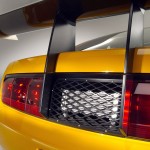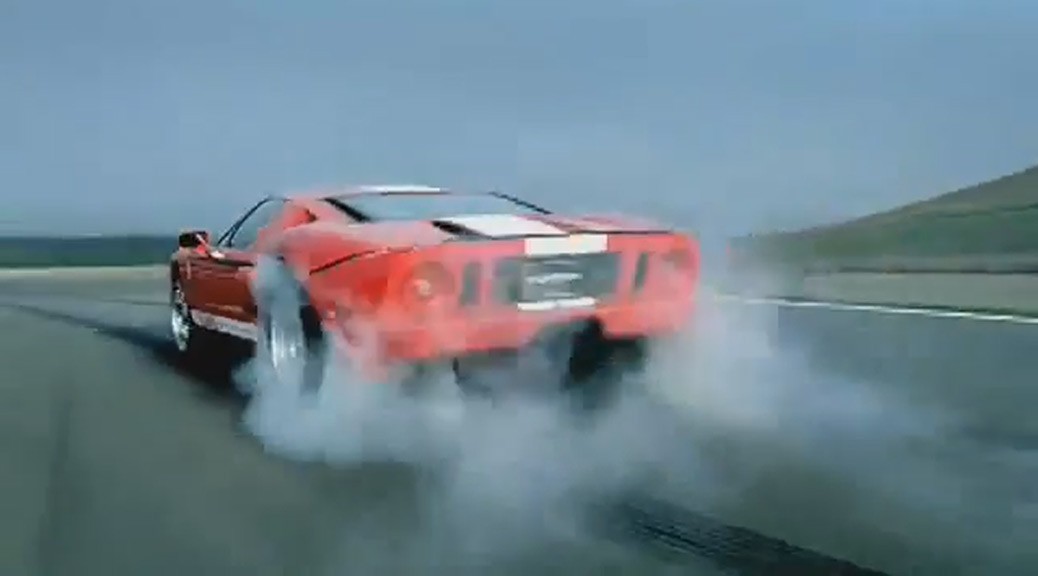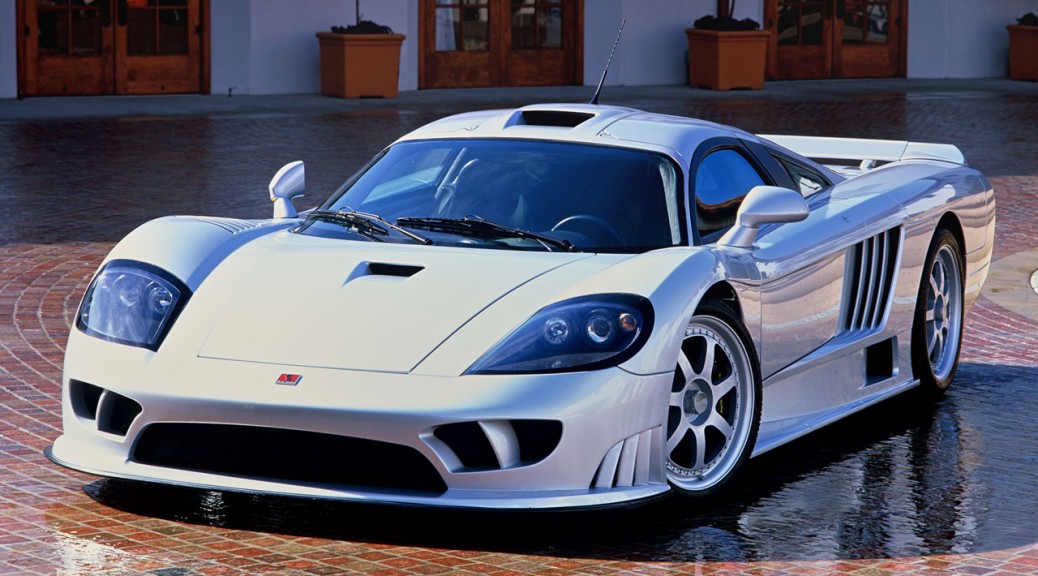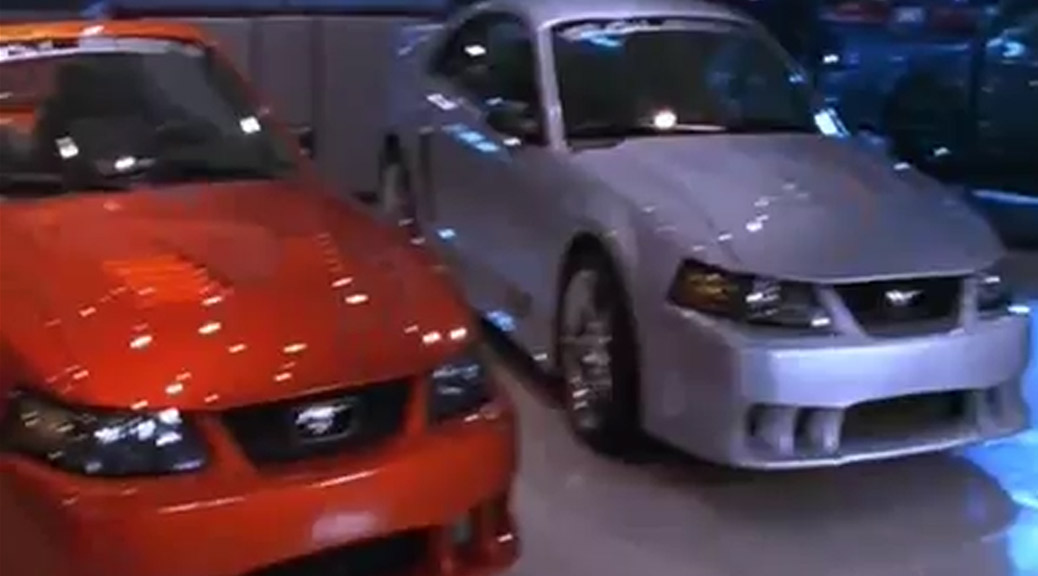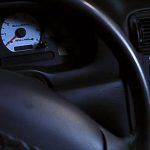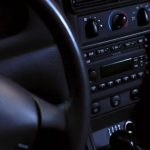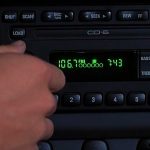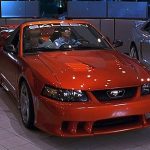NEW YORK, April 7, 2004 – The muscular Ford Mustang GT-R rekindles the legend’s road racing glory and the magic of 5.0-liter Mustangs in a stunning racing concept making its world debut today. The Mustang GT-R signals a potential future race car, while honoring four decades of performance glory just days before Mustang’s 40th anniversary.
The bright Valencia Orange car – inspired by the famous Grabber Orange 1970 Mustang Boss 302 Trans-Am race cars (the Yellow Mustangs) piloted by race legends, including Parnelli Jones – is a technological showcase that, when peeled back, reveals a number of existing or production-feasible racing parts.
Built at Saleen Special Vehicles in Troy, Mich., the car was developed by the same members of the Ford GT “Dream Team” who are building sub-assemblies and painting body panels for Ford’s first supercar.
The Mustang GT-R features Ford Racing’s 440-horsepower “Cammer” crate engine that already is affordably available to grassroots racers, and can be tuned to produce more than 500 horsepower under certain race series rules. Last year, a tuned 505-horsepower version of the “Cammer” notched world-class performance and endurance credentials by powering a Focus Daytona Prototype to victory at the 24 Hours of Daytona race.
The racecar is engineered to tackle the world’s toughest road and street courses with a stiff structure – based on the all-new 2005 Mustang scheduled for sale this fall – a collection of the most sophisticated racing parts from many racing series and a Formula One-inspired steering wheel. However, the Mustang GT-R could be easily transformed into an affordable, competitive option for grassroots teams because it uses 85 percent of the 2005 Mustang’s body components along with the same suspension setups and the already-attainable “Cammer” powerplant.
“The Mustang GT-R could be adapted to conform to different series and budgets but, in this variation, serves as a dream machine. We took the ‘Cammer’ engine from the Ford Racing catalog and built a race car around it with the best parts we’ve researched and tested through our unmatched global racing program,” Davis says.
Design
Doug Gaffka’s – design director, Ford Performance Group – design inspiration for the Mustang GT-R was simple: Flex the 2005 Mustang shell to wrap the engine and retain 85 percent of the production car’s solid structure.
The front end is a further evolution of the Mustang GT coupe and convertible concepts that stole the 2003 North American International Auto Show and foreshadowed the design of the 2005 Mustang. The Mustang GT-R features the classic pony in the grille, surrounded by modern materials like carbon fiber as well as advanced aerodynamic treatments like ground-hugging front and side splitters.
The equally large rear fenders house tires that are an inch wider. Considering how quickly 18- and 19-inch tires became standard racing ware in recent years, the 20″ tires on the GTR are a realistic forecast of the next evolution in racing rubber.
The classic Mustang rear quarter windows are blocked out to accommodate the fuel delivery “dry-brake” system on the driver’s side. The doors are fully functional as required by many of the possible racing classes.
Probably the most striking design element, the prominent composite rear spoiler meets several road racing sanctioning body rules. The rear fascia, like the front, is a further expression of the GT concept design, with a wider taillamp execution. Endurance racers will instantly recognize the differential cooler mounted with an aluminum grille screen between the taillamps.
The Mustang GT-R’s body retains 85 percent of the production car’s body components that were stiffened by 30 percent as part of the Mustang’s first full makeover ever. The only modifications include rear-mounted battery pods and a fuel cell relocated to the rear trunk.
The “Five Liter” Is Back
The foundation for the Mustang GT-R’s race-prepared 440-horsepower engine is the new 5.0-liter “Cammer” crate engine from Ford Racing Performance Parts. The engine is rooted in the MOD 4.6-liter four-valve V-8 engine family. However, the motor’s flanged cylinder liners help provide 94mm (instead of 90.2mm) cylinder bores, creating a full 5.0 liters of piston displacement.
And while the motor employs the SVT Mustang Cobra’s forged crankshaft with six-bolt mains and Manley “H-Beam” connecting rods for superior strength, the high-strength Ford Racing block features design reinforcements and a revised material for added strength and high-output durability. The block is specially reinforced in the crankcase web areas for high torque loads.
Other key differences include forged pistons, an 11.0:1 compression ratio, ported heads, higher-lift cams and beehive-shaped valve springs. The crate engine also features higher-flow fuel injectors and a magnesium, variable-geometry intake manifold.
The 5.0-liter “Cammer” engine comes with a custom oil pan and features custom-fabricated Tri-Y headers and crossover.
Helping put the power to the ground is the Ford Racing-supplied TTC T-56 six-speed transmission linked to the engine through a heavy-duty clutch and flywheel assembly. Power exits the transmission through a custom metal matrix composite aluminum driveshaft into a race-specification differential with a 4.56:1 final drive ratio.
Proven Race Chassis
The Mustang GT-R benefits from the 2005 Mustang’s race-inspired chassis, developed and tuned by engineers with Ford Racing engineering experience or a passion for weekend track time. The Mustang’s race-bred suspensions, near 50-50 weight distribution and ultra-stiff body structure, are just the beginning of Mustang GT-R’s credentials.
Soon after the 2005 Mustang’s world reveal in January, race engineers quickly began building on its solid foundation. The Mustang GT-R concept’s chassis was fully stripped down to the body shell to receive custom reinforcement and structural improvements for driver safety on the racetrack. A roll cage was added, along with a Sparco-brand racing seat with a five-point safety harness.
The production suspension geometry is retained, but key parts were replaced to reduce weight or provide additional strength for the rigors of racing. Suspension pieces, including the K-member, are made of lightweight chrome-moly tubing. The race-proven dampers are coil-over, fully adjustable units featuring remote reservoirs. A strut tower brace increases structural rigidity.
Rounding out the chassis package are huge, race-proven Brembo brakes. The front features 14.3-inch rotors with six-piston calipers; the rear has 13-inch rotors with four-piston calipers. Linking the whole package to the racetrack are 20-inch wheels and racing slicks provided by Pirelli. Tire sizes range from 275/35 in front to 305/30 in the rear.
While conceptual in spirit, the Mustang GT-R is built by racers and is a capable performer with an eye on stepping up Mustang’s road-racing presence. Several racing series – American LeMans, SCCA Trans-Am, GrandAm Cup and the FIA – could easily accommodate the Mustang GT-R. For example, the car could meet some series rules with basic modifications to the brakes, wheels, tires and body parts.
The Mustang GT-R also hints at a turnkey grassroots-racing package that could be retailed through Ford Racing’s parts’ catalog and distribution network.
Engine – Ford Racing 5.0L “Cammer” V8
Configuration
V-8, aluminum block, aluminum four-valve cylinder heads, forged aluminum pistons
Bore x Stroke
94 mm bore x 90.0 mm stroke
Displacement
5.0 liters (302 cu in/4995 cc)
Compression ratio
11.0:1
Horsepower
440 @ 7000 rpm
Torque
400 lb-ft @ 5500 rpm
Redline
7,000 rpm
Valvetrain
Double overhead camshafts, four valves per cylinder
Intake valves
Two per cylinder, 38 mm
Exhaust valves
Two per cylinder, 32 mm
Throttle body
Twin 57 mm
Transmission
Ford Racing/Tremec T-56 6-speed
Rear axle
Winters/Ford 9-inch design
Differential
Winter’s race-spec rear differential
Clutch
Ford Racing “Cobra R” heavy-duty clutch/flywheel assembly
Driveshaft
Metal matrix composite aluminum custom driveshaft
Exhaust
Complete stainless steel race exhaust with Tri-Y design headers, crossover and side exit tips
Chassis
Fully reinforced fabrication
Suspension
Original production geometry with lightweight chrome-moly tube (aircraft quality) construction
Front
Reverse-L independent rigid strut tower brace with lightweight chrome-moly K-member and race-spec anti-sway bar with 1.25-inch box section
Rear
Three-link, solid axle with dynamic, fully adjustable shocks with remote reservoirs and coil-over springs, race-spec 1.25-inch panhard rod, and race-spec anti-sway bar
Brakes
Front
Brembo Racing 6-piston calipers and 14.3-inch rotors, 1.25-inch thickness
Rear
Brembo Racing 4-piston calipers and 13-inch rotors, 1.25-inch thickness
Wheels & Tires
Front
Pirelli P275/35/20 racing slicks
20 x 10-inch, 5-spoke billet aluminum wheels
Rear
Pirelli P315/30/20 racing slicks
20 x 11-inch, 5-spoke billet aluminum wheels






